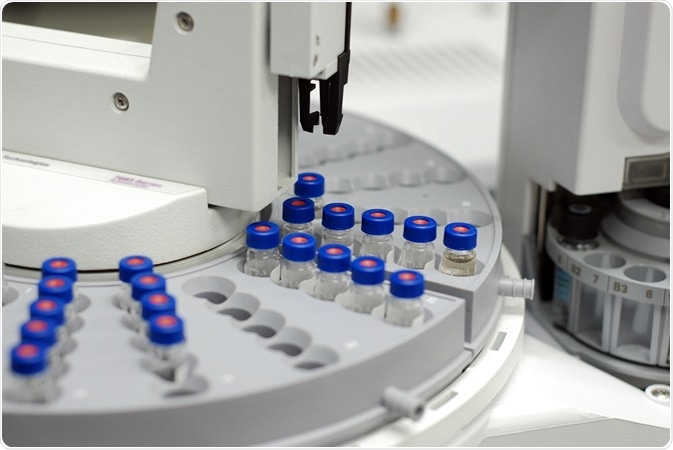Targeted metabolomics is a quantitative approach of metabolomics as it depends on measuring the known metabolites of specific pathways. Since targeted metabolomics is a continually evolving field, it faces enormous obstacles in its widespread approach.

Credit: Yenyu Shih/ Shutterstock.com
Challenges related to technology
Presently, in targeted metabolomics, no single analytical method is capable of delivering information besides a portion of the metabolite. The following were the limitations even after using tools and techniques together:
- The obtained data were particularly on a fraction of metabolites
- The techniques themselves had some specific limitations
However, a number of endogenous metabolite results are simultaneously analyzed in a difficult situation owing to their different chemical structures and physicochemical properties. Chromatography-related mass spectroscopy (MS) and nuclear magnetic resonance (NMR) spectroscopy are the two major analytical tools employed for the analysis of metabolites in biological samples.
MS-based metabolomics
An average misstep in MS-based metabolomics is disregarding sudden changes in the quantity of other metabolites. In addition, the samples of interest are initially examined using common analytical techniques in targeted analysis, which are as follows:
Gas chromatography (GC)-MS
It is capable of detecting any organic metabolite that is volatile irrespective of its structure. Even after chemical derivatization, the analysis of nonvolatile compounds using GC-MS has a drawback due to relatively reduced sample output when more samples are examined.
Liquid chromatography (LC)-MS
It has been reported that the precision of investigational data is affected when exploiting LC-MS in targeted metabolomics.
Electrospray ionization (ESI)
This method enables the MS-based analysis to detect nonvolatile metabolites. Sadly, ESI causes ion suppression and matrix effects among metabolites during analysis, which is a major limitation.
Labeled isotopes
Due to analytical obstacles like ion suppression and sample–sample variance in MS-based metabolomics, targeted metabolomics currently employs the isotope-labeled internal standards for comprehensive measurement of metabolites.
Standard isotopic mixtures were available only for some metabolites such as sugars, amino acids, and lipids, which is another bottleneck. It has been anticipated that determining the absolute concentration of broad spectra of metabolites by preparing stable isotope-labeled standards for other metabolites would help targeted metabolomics. Implementation of this process will require more time and significance.
https://youtu.be/uSG8ANBTaN0
Nuclear magnetic resonance (NMR) spectroscopy
NMR experiments mainly necessitate a pure sample in adequate measure, which frequently demands hard and challenging attempts for all minor metabolites in a complex mixture.
Challenges related to data analysis
Elucidation of the structure of primary and secondary metabolites is a challenging task, even for a professional spectroscopist. Exploding realization of the exceedingly broad complexity of biological samples highlights more challenges, which include:
- Identification of unknown metabolites
- Validation of biomarkers
- Inter-laboratory reproducibility
Identification and interpretation of unknown metabolites:
Previously, the genome information and fragmentation database comprised a list of metabolites present in each target species and specimen. Unfortunately, targeted metabolomics faces a difficult situation, because it does not have a complete list of human and more naturally arising metabolites, unavailable from both the genome and fragmentation databases.
Most unknown metabolites resemble the parent compound; fragmentation information provides the structural characterization of the parent compound, which is related to unknowns. Many times, it fails to provide data as the parent compounds are themselves unknown. So, targeted metabolomics obtains information on several annotable metabolites present in biological samples from many databases and by using software, so that they can be compared and further interpreted for the purpose of disease diagnostics.
Overcoming aspects
Presently, the following databases of naturally appearing metabolites have been established:
- Human metabolome database, which includes 8021 human endogenous metabolites
- Evidence-based metabolome library
In addition, the evolution of computational mass spectrometry (CompMS) has been valuable in the structural elucidation of many metabolites, as it is inbuilt with some methods for deeper understanding of metabolite chemistry. The other methods include silico derivatization, tandem mass spectra prediction, and spectral libraries for comparing with previous analysis.
Biomarker validation
Targeted metabolomics subsequently focuses on the discovery of biomarkers, which enables understanding the defective mechanism underlying a disease stage. But working on the validation of an individual biomarker in the metabolomic setting was found to be quite challenging due to the huge cost involved in the large cohort studies.
Moreover, cohort studies do not continually result in a huge success. In the past 15 years, about 150,000 studies have been carried out; these have yielded only 100 biomarkers, which have been completely validated and implemented therapeutically. There is, therefore, a need for well-designed cohort studies for validating the biomarker performance.
Inter-laboratory reproducibility
Reproduction of data on one particular metabolite is a difficult as well as time-consuming task because of the enormous number of metabolites which are present in the biological system. Reproducible data are obtained only on important metabolites involved in a disease, and not for the minor metabolites associated with the disease.
Today, targeted metabolomics aims at achieving inter-laboratory reproducibility, wherein one laboratory conducts an experiment on a particular metabolite and the data obtained are transmitted to other laboratories to check their reproducibility. This will enable achievement of standardization in targeted metabolomics.
Further Reading